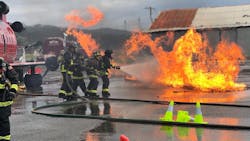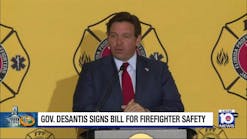Study: Female FFs Face Same Cancer Risks as Males
By Jerimiah Oetting
Source The Mercury News
Female firefighters in San Francisco have higher concentrations of certain cancer-linked chemicals in their blood than women in other occupations, according to the first study to investigate how women in the profession are exposed to chemicals in the line of duty.
When the San Francisco Fire Department suffered a shocking spate of breast cancers in 2012, it prompted a collaborative effort to investigate the exposure among women to hazardous chemicals, specifically chemicals called per- and polyfluoroalkyl substances, or PFAS. These “forever chemicals” can bioaccumulate in tissues and persist over lifetimes, and are linked to several types of cancers, including breast cancer, and other diseases.
“We know running into a burning building — there’s some occupational hazards there,” said Heather Buren, a lieutenant and paramedic at the San Francisco Fire Department who co-authored the study. “But the idea that we were being exposed to chemicals that were causing cancer … it’s not as sexy.”
Buren said between 2011 and 2012, five of her coworkers were diagnosed with breast cancer within the same year. She said that number may be higher, because not everyone was vocal about having the disease.
“Being female in a male dominated profession … it was a really private thing for them,” she said.
The women were in their 40s, getting breast cancers that scientists and doctors say they don’t usually see in women under 60.
“For the first time, I started thinking of (cancer as an) occupational disease,” she said. “Could our job actually be part of the reason this is happening?”
Anita Paratley is a battalion chief for the San Francisco Fire Department. She developed breast cancer in 2003, when she was 46 years old.
“I remember when I raised my hand to swear-in (to the fire service), thinking ‘please be safe, don’t get hurt in a fire,'” she said. “I never thought about cancer.”
After being diagnosed, Paratley tried to learn if the disease may have been caused by her job. But she couldn’t find any information on women in the fire service.
“Frankly, they need to be studying, in general, about women’s health,” she said. “Do we absorb things at a greater rate than men — who knows?”
Buren said watching so many of her friends suddenly develop cancer made her worried about herself. She knew that being exposed to cancer-causing chemicals was part of firefighting. Was she going to be next?
“(When) people who look like you, who are doing your job, who are your friends, are getting a disease, you start to ask: ‘Could that be me? Could I be the next one?'” said Buren.
Women only comprise about 5% of the firefighters across the country, according to the U.S. Bureau of Labor Statistics. Because their numbers are so few, they’re often excluded from studies about the health risks of firefighting. But of the 1,600 firefighters in San Francisco, nearly 300 are women — the highest percentage in the nation.
“Having a large group of women in San Francisco and interest from the community to answer these questions — that’s why (this study is) important,” said Jessica Trowbridge, a researcher at UC Berkeley and the lead author of the study. “Their exposure and risk has not been characterized in the scientific literature.”
PFAS chemicals are in many household items: food packaging, furniture, carpets — they can even be detected in drinking water. Because the chemicals degrade so slowly, they persist in the environment and human tissues. A National Health and Nutrition Examination Survey in 2003 found that over 98% of the population surveyed had multiple types of PFAS in their bodies.
PFAS are also a major component of the foams firefighters use to put out fires. The researchers said contact with the foam, as well as breathing particulates in the air from burning buildings, might contribute to the firefighters’ higher exposure levels of carcinogenic chemicals.
It might also help explain why firefighters have higher levels of cancer.
Through a network of groups, including the San Francisco Firefighters Cancer Prevention Foundation, Buren said a groundswell of concern from firefighters, advocates and scientists led to the creation of the Women Workers Biomonitoring Collaborative (WWBC) — a group determined to fill the knowledge gaps between male and female firefighters.
“They’re very active, driven people,” said Trowbridge of the female firefighters in the collaborative. “They weren’t going to sit around and wait for somebody to come save them. They were going to do something to solve this problem.”
The results show that most firefighters had significantly higher concentrations of three PFAS chemicals compared with the office workers that were also tested. Each of the 86 firefighters involved in the study were given their results and information about how to prevent exposure in the future.
“I can’t speak to their breast cancer risk,” Trowbridge said. “But I can speak to the level of chemicals that we found in their body, and that they had higher levels of some of these compounds than the non-firefighters.”
Buren said that she’s visited departments across the country to educate firefighters about how to reduce their exposure — cleaning their gear, washing their hands and showering as soon as possible after a fire.
“It’s this whole idea where the dirtier the gear is, the saltier you are, the more fires you’ve fought, the more experience you have,” she said. “That’s sort of ingrained into this masculine culture, and it’s taken a little bit of time to start to change that.”
As battalion chief, Paratley said it’s her job to make sure her crew is safe, and that now includes an awareness of carcinogenic particulates that are in the air after a fire, and that coat the crew’s work gear.
“I’m responsible to make sure these changes are enforced,” she said. “That’s part of safety, even though the fire is out.”
The study provides evidence that cancer is an occupational hazard for firefighters, something that both firefighters said can also help people receive workers’ compensation claims when they get sick.
When Paratley filed her claim back in 2003, she was initially denied.
“They asked me what I was exposed to, and I said, ‘I’m a firefighter, I’m not a chemist,” she said. “Is this a test? I didn’t know about flame retardants.”
Luckily, California has presumptive laws that assume if a firefighter develops cancer, it’s likely due to exposure through their job. Paratley’s claim was approved because of those laws, but not every state has those protections.
“This gives people solid support, scientific evidence, to go to these legislators” and add cancers to these lists of occupational hazards, Buren said.
“You shouldn’t have to fight for your benefits as you’re fighting for your life,” she said.
———
©2020 the San Jose Mercury News (San Jose, Calif.)
Visit the San Jose Mercury News (San Jose, Calif.) at www.mercurynews.com
Distributed by Tribune Content Agency, LLC.






